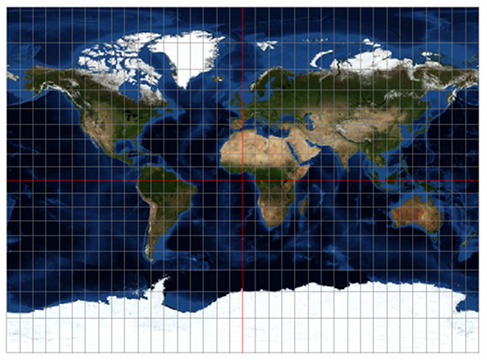Package com.luciad.projection
Class TLcdMillerCylindrical
java.lang.Object
com.luciad.projection.ALcdProjection
com.luciad.projection.ALcdCylindrical
com.luciad.projection.TLcdMillerCylindrical
- All Implemented Interfaces:
ILcdCylindrical,ILcdProjection,ILcdPropertyChangeSource,Serializable,Cloneable
Miller Cylindrical projection.
Introduction
The Miller cylindrical projection is a modified Mercator projection. The parallels of latitude are scaled by a factor of 0.8, projected according to Mercator and then the result is divided by 0.8 to retain scale along the equator.
Properties
- Cylindrical projection. It is neither equal-area nor conformal.
- Meridians are shown as equally spaced straight lines.
- Parallels are also shown as straight lines but they are unequally spaced.
- Meridians and parallels intersect each other at right angles.
- Poles are shown as lines.
Example

Sample code
ILcdProjection projection =
new TLcdMillerCylindrical(0.0);
Implementation aspects
The equations of the Miller cylindrical projection are taken from [Snyder1987].
- Since:
- V 3.0
- See Also:
-
Field Summary
Fields inherited from class com.luciad.projection.ALcdProjection
fPropertyChangeDispatcherFields inherited from interface com.luciad.projection.ILcdProjection
EPSILON -
Constructor Summary
ConstructorsConstructorDescriptionConstructs a Miller cylindrical projection with the central meridian at 0.TLcdMillerCylindrical(double aCentralMeridian) Constructs a Miller cylindrical projection with a given central meridian. -
Method Summary
Modifier and TypeMethodDescriptiondouble[][]boundaryLats(double aLongitude) Default implementation.double[][]boundaryLons(double aLatitude) Default implementation.booleaninLonLatBounds(ILcdPoint aLLHP) Checks if anILcdPointis inside the valid area of geodetic coordinates of the projection.booleaninWorldBoundsOnSphere(ILcdPoint aXYPoint, double aRadius) Checks if aILcdPointis inside the valid cartesian area of the projection.booleanIf all geodetic coordinates (l ,j ) are projected (visible) by anILcdProjectionand all (x,y ) coordinates are bounded this istrue.voidlonlatheight2worldOnSphereSFCT(ILcdPoint aLLHP, double aRadius, ILcd2DEditablePoint aXYPointSFCT) Transforms anILcd2DEditablePointon a sphere into the cartesian coordinate system of the projection.toString()Returns theStringrepresentation of the Miller cylindrical projection.voidworld2DEditableBoundsOnSphereSFCT(double aRadius, ILcd2DEditableBounds aWorldBounds) Sets theILcd2DEditableBoundsobject to the bounds of the projection in world coordinates.voidworld2lonlatOnSphereSFCT(ILcdPoint aXYPoint, double aRadius, ILcd2DEditablePoint aLLPointSFCT) Transforms anILcdPointfrom the cartesian coordinate system of the projection into anILcd2DEditablePointonto a sphere.Methods inherited from class com.luciad.projection.ALcdCylindrical
calculateCachedValues, clone, equals, getCentralMeridian, getOrigin, hashCode, isContinuous, loadProperties, setCentralMeridian, writePropertiesSFCTMethods inherited from class com.luciad.projection.ALcdProjection
addPropertyChangeListener, firePropertyChangeEvent, inWorldBoundsOnEllipsoid, lonlatheight2worldOnEllipsoidSFCT, removePropertyChangeListener, world2DEditableBoundsOnEllipsoidSFCT, world2lonlatOnEllipsoidSFCTMethods inherited from class java.lang.Object
finalize, getClass, notify, notifyAll, wait, wait, waitMethods inherited from interface com.luciad.projection.ILcdProjection
inWorldBoundsOnEllipsoid, lonlatheight2worldOnEllipsoidSFCT, world2DEditableBoundsOnEllipsoidSFCT, world2lonlatOnEllipsoidSFCTMethods inherited from interface com.luciad.util.ILcdPropertyChangeSource
addPropertyChangeListener, removePropertyChangeListener
-
Constructor Details
-
TLcdMillerCylindrical
public TLcdMillerCylindrical()Constructs a Miller cylindrical projection with the central meridian at 0. -
TLcdMillerCylindrical
public TLcdMillerCylindrical(double aCentralMeridian) Constructs a Miller cylindrical projection with a given central meridian.- Parameters:
aCentralMeridian- the central meridian for the Miller cylindrical projection.
-
-
Method Details
-
isAllInBounds
public boolean isAllInBounds()Description copied from interface:ILcdProjectionIf all geodetic coordinates (l ,j ) are projected (visible) by anILcdProjectionand all (x,y ) coordinates are bounded this istrue. AllILcdProjectionobjects have bounded (x,y ) coordinates because the projection is cut off if necessary.- Returns:
trueif all LonLatPoints are within the bounds of the projection,falseotherwise.
-
lonlatheight2worldOnSphereSFCT
public void lonlatheight2worldOnSphereSFCT(ILcdPoint aLLHP, double aRadius, ILcd2DEditablePoint aXYPointSFCT) throws TLcdOutOfBoundsException Description copied from interface:ILcdProjectionTransforms anILcd2DEditablePointon a sphere into the cartesian coordinate system of the projection.- Parameters:
aLLHP- point to be projected.aRadius- radius of the sphere (meters).aXYPointSFCT- projected point as side effect.- Throws:
TLcdOutOfBoundsException- If theILcdPointaLLHPis not within the valid area of the projection (visible area), then this exception is thrown.
-
world2lonlatOnSphereSFCT
public void world2lonlatOnSphereSFCT(ILcdPoint aXYPoint, double aRadius, ILcd2DEditablePoint aLLPointSFCT) throws TLcdOutOfBoundsException Description copied from interface:ILcdProjectionTransforms anILcdPointfrom the cartesian coordinate system of the projection into anILcd2DEditablePointonto a sphere.- Parameters:
aXYPoint- projected point for which the corresponding geodetic point is sought.aRadius- radius of the sphere (meters).aLLPointSFCT- resulting geodetic coordinate as side effect.- Throws:
TLcdOutOfBoundsException- If theILcdPointaXYPointis not within the valid area of the projection (visible area), then this exception is thrown.
-
inLonLatBounds
Description copied from interface:ILcdProjectionChecks if anILcdPointis inside the valid area of geodetic coordinates of the projection. The valid area is determined by the LonLatPoints that are visible and for which the corresponding cartesian coordinate is within the boundaries.- Parameters:
aLLHP-ILcdPointto be checked upon.- Returns:
trueif valid,falseif invalid.
-
inWorldBoundsOnSphere
Description copied from interface:ILcdProjectionChecks if aILcdPointis inside the valid cartesian area of the projection. The valid cartesian area is determined naturally by the projection bounds or by an artificial introduced boundary limit because some cartesian points are at infinity. The shape of the valid cartesian area is in many cases rectangular or circular although it might be more complex.- Parameters:
aXYPoint- point to be checked upon.aRadius- radius of the sphere.- Returns:
trueif valid,falseif invalid.
-
world2DEditableBoundsOnSphereSFCT
Description copied from interface:ILcdProjectionSets theILcd2DEditableBoundsobject to the bounds of the projection in world coordinates.- Parameters:
aRadius- radius of the sphere.aWorldBounds- the bounds of the projection in world coordinates as side effect.
-
boundaryLons
public double[][] boundaryLons(double aLatitude) Description copied from class:ALcdProjectionDefault implementation. To be redefined for specific projections.- Specified by:
boundaryLonsin interfaceILcdProjection- Overrides:
boundaryLonsin classALcdProjection- Parameters:
aLatitude- latitude in decimal degrees and -90.0 <=aLat<= 90.0.- Returns:
- the array of pairs of longitudes[0] and longitudes[1], where the closed interval longitudes[0] -> longitudes[1] is in visible area and -180.0 <= lon[i] <= 180.0.
-
boundaryLats
public double[][] boundaryLats(double aLongitude) Description copied from class:ALcdProjectionDefault implementation. To be redefined for specific projections.- Specified by:
boundaryLatsin interfaceILcdProjection- Overrides:
boundaryLatsin classALcdProjection- Parameters:
aLongitude- longitude in decimal degrees -180.0 <= lon <= 180.0 .- Returns:
- the array of pairs of latitudes lats[0] and lats[1], where the closed interval lats[0] -> lats[1] is in visible area and -90.0 <= lats[i] <= 90.0 .
-
toString
Returns theStringrepresentation of the Miller cylindrical projection.- Specified by:
toStringin interfaceILcdProjection- Overrides:
toStringin classObject- Returns:
- the
Stringrepresentation of the Miller cylindrical projection.
-